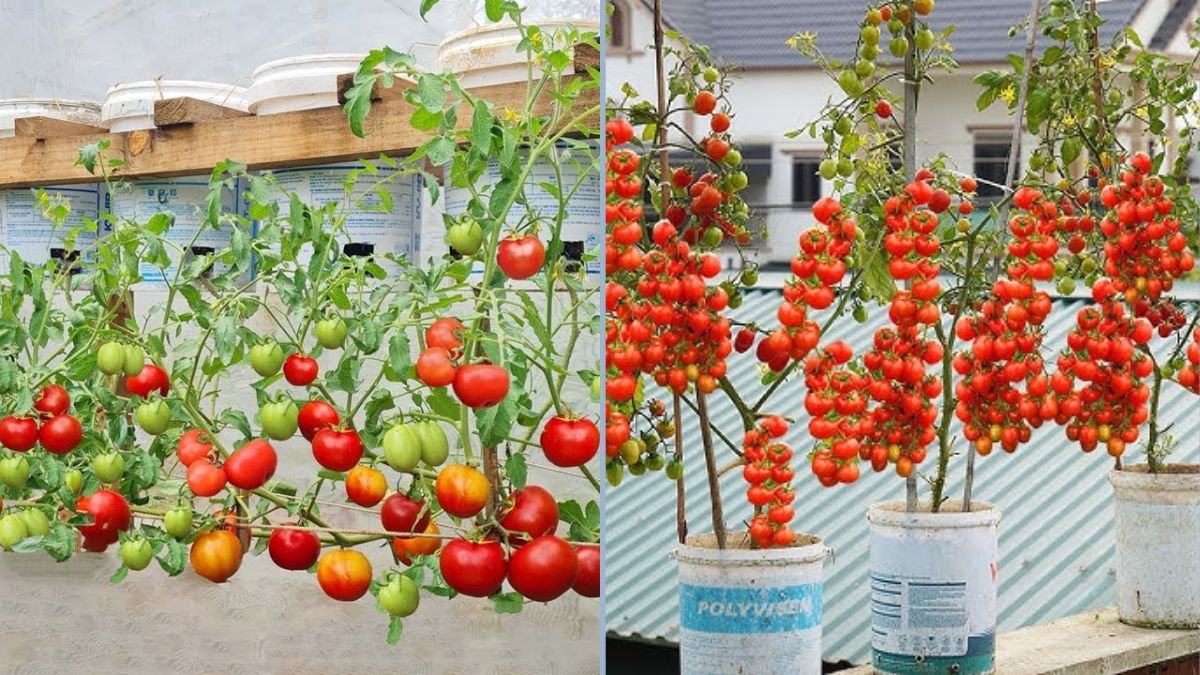Tomatoes are a staple in kitchens worldwide, loved for their sweet, tangy flavor and versatility in countless dishes. From fresh salads and sauces to soups and stews, nothing beats the taste of a homegrown tomato. But what if you could produce three times more tomatoes than usual, even in limited space?
The secret lies in growing tomatoes in plastic containers with the right method. This approach is ideal for urban gardeners, small-space growers, or anyone who wants to maximize yield without expanding their garden. By optimizing soil, watering, and container placement, you can enjoy a bountiful harvest of juicy, flavorful tomatoes.
This blog will guide you step-by-step on how to grow tomatoes in plastic containers to achieve maximum yield, along with care tips, pest management, and harvesting techniques.
Why Grow Tomatoes in Plastic Containers?
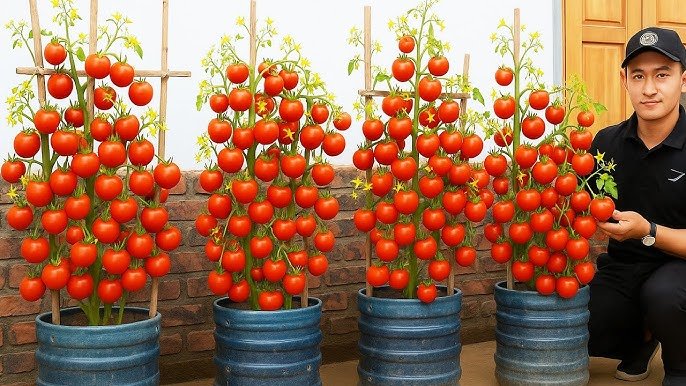
1. Space Efficiency
Plastic containers allow gardening in small areas such as balconies, patios, or rooftops. Vertical arrangements and proper spacing help maximize yield in limited spaces.
2. Better Root Management
Containers restrict root growth in a controlled way, which encourages strong, healthy root systems that absorb nutrients efficiently, resulting in bigger fruits.
3. Enhanced Drainage
Properly prepared containers prevent waterlogging and root rot. Tomatoes are sensitive to standing water, and container gardening ensures ideal drainage.
4. Cost-Effective
Plastic containers are inexpensive and often recyclable. They provide an affordable solution for starting your tomato garden without investing in raised beds.
5. Mobility
Containers are portable. You can move them to optimize sunlight, protect plants from extreme weather, or rotate crops easily.
Understanding Tomato Growth
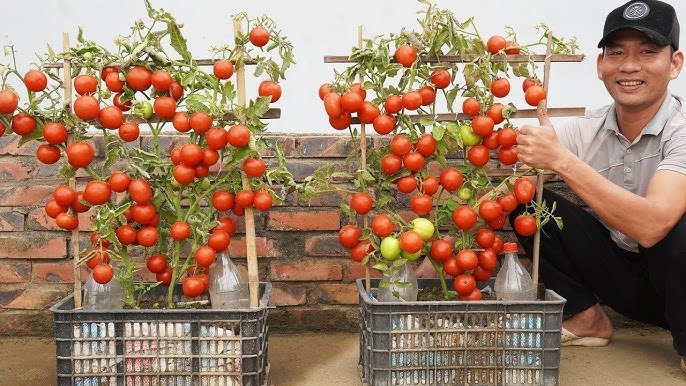
Before starting, it’s essential to know how tomatoes grow:
- Warm-Season Crop: Tomatoes thrive in 70–85°F (21–29°C) with full sunlight.
- Nutrient-Hungry Plants: Tomatoes require rich, well-draining soil with plenty of organic matter.
- Fruit Development: Tomatoes need consistent watering, fertilization, and proper pruning to produce multiple fruits per plant.
- Pollination: While self-pollinating, tomatoes benefit from wind or insect activity to increase fruit set.
Understanding these factors ensures your plants produce healthy, high-yield fruits.
Materials Needed
To grow tomatoes successfully in plastic containers, you’ll need:
- Plastic containers – 5–10 liters or larger, with drainage holes
- Potting mix – Soil, compost, and sand mix for aeration and nutrients
- Tomato seedlings or seeds – Choose high-yield varieties
- Slow-release fertilizer – For consistent nutrition
- Stakes or trellises – For support
- Watering can – For regular irrigation
Step-by-Step Guide to Growing Tomatoes in Containers
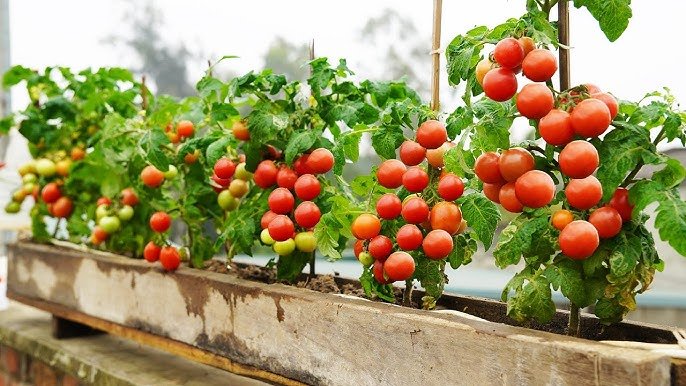
Step 1: Prepare the Container
- Ensure the container has drainage holes at the bottom.
- Clean the container thoroughly to remove residues or pathogens.
- Optionally, place a layer of gravel or small stones at the bottom to improve drainage.
Step 2: Add Soil and Fertilizer
- Fill the container with a mix of potting soil, compost, and sand.
- Mix in slow-release fertilizer to provide nutrients throughout the growing season.
- Leave about 2 inches from the top to make watering easier.
Step 3: Planting Tomatoes
- Seeds: Sow 2–3 seeds per container about ¼ inch deep.
- Seedlings: Transplant young plants carefully, burying part of the stem to encourage additional root growth.
- Water gently to settle the soil around the roots.
Step 4: Placement and Sunlight
- Place containers in a sunny spot receiving at least 6–8 hours of direct sunlight daily.
- Rotate containers every few days for uniform light exposure.
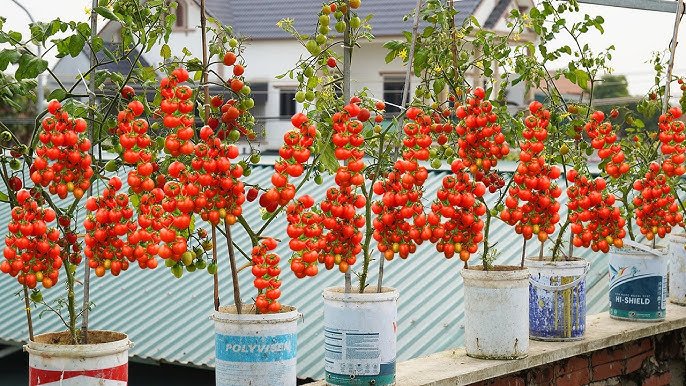
Watering and Care
- Consistency is Key: Tomatoes need regular watering, especially during flowering and fruit development.
- Avoid Overwatering: Keep soil moist but not soggy to prevent root rot.
- Mulching: Cover the soil with straw or dry leaves to retain moisture, regulate temperature, and prevent weed growth.
Fertilizing for Maximum Yield
- Early Stage: Use a nitrogen-rich fertilizer to encourage strong stem and leaf growth.
- Flowering & Fruiting Stage: Switch to a phosphorus and potassium-rich fertilizer to promote fruit development and increase size.
- Frequency: Fertilize every 2–3 weeks with liquid or slow-release fertilizer.
- Avoid excessive nitrogen during fruiting to prevent leafy growth at the expense of fruits.
Supporting Tomato Plants
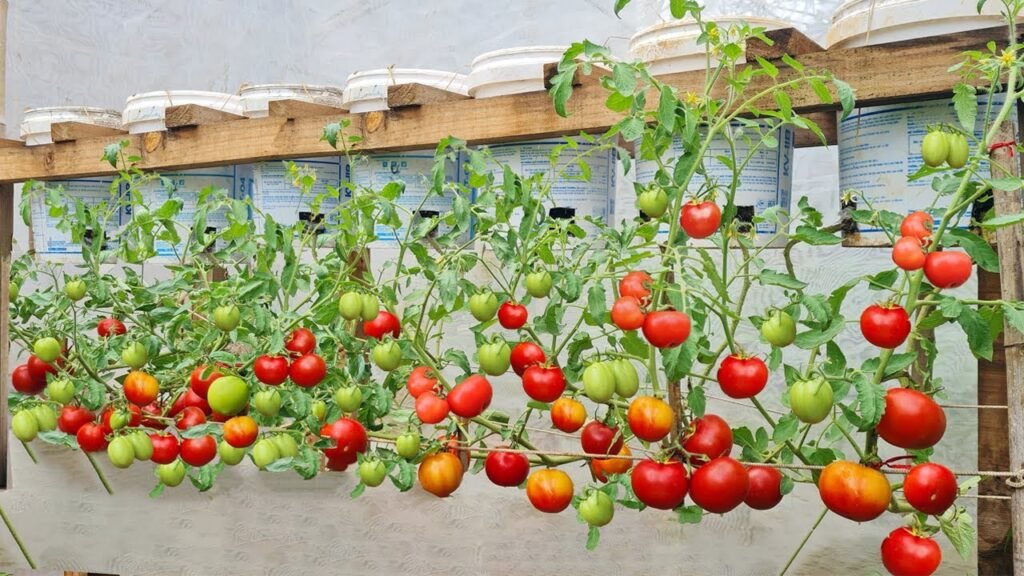
- Stakes or Cages: Use stakes, trellises, or cages to support growing plants and prevent sprawling on the ground.
- Pruning: Remove side shoots (suckers) to focus the plant’s energy on fruit production.
- Leaf Maintenance: Trim yellowing or diseased leaves to improve airflow and reduce disease risk.
Managing Pests and Diseases
Even container-grown tomatoes are vulnerable to pests:
- Aphids: Spray with neem oil or mild soap solution.
- Whiteflies & Spider Mites: Inspect leaves regularly and treat with natural insecticides.
- Fungal Diseases: Avoid wetting foliage during watering and ensure proper spacing between plants for airflow.
Preventive care and early intervention are key to maintaining healthy plants.
Harvesting Tomatoes
- Timing: Harvest when fruits are fully colored, firm, and slightly soft to the touch.
- Method: Use scissors or a knife to cut fruits from the plant, leaving a small stem attached to prolong shelf life.
- Frequency: Regular harvesting encourages continuous fruit production.
Advantages of This Method
- Increased Yield: Proper container gardening can produce up to three times more tomatoes compared to traditional methods.
- Urban-Friendly: Perfect for apartments, patios, and balconies.
- Cost Savings: Reduces the need to buy store-bought tomatoes.
- Healthier Produce: Homegrown tomatoes are fresh, pesticide-free, and nutrient-rich.
- Eco-Friendly: Reuses plastic containers and reduces gardening waste.
Tips for Maximizing Yield
- Succession Planting: Start new seedlings every few weeks for a continuous harvest.
- Consistent Sunlight: Rotate containers and ensure plants receive sufficient light.
- Adequate Watering: Avoid over- or under-watering; consistency is crucial.
- Support and Pruning: Proper staking and pruning lead to larger fruits.
- Pollination: Encourage insects or gently shake flowers to ensure proper pollination.
Culinary Uses for Homegrown Tomatoes
- Fresh Salads: Crisp, sweet tomatoes are perfect for salads.
- Sauces & Soups: Make your own sauces, soups, and pasta dishes.
- Roasted Dishes: Roast with herbs for a flavorful side.
- Preserving: Can or freeze surplus tomatoes for later use.
- Snacks: Cherry or grape tomatoes are great as healthy snacks.
Growing your own tomatoes ensures you always have fresh ingredients on hand.
Conclusion
Growing tomatoes in plastic containers is a highly effective, space-saving, and sustainable method for producing large, juicy fruits. By following proper planting, watering, fertilization, and pruning techniques, you can achieve up to three times more yield than traditional soil planting methods.
This approach is perfect for urban gardeners, small-space growers, and anyone who wants fresh, homegrown tomatoes year-round. Not only does it save money, but it also allows you to enjoy superior flavor and nutrition.
With patience, care, and attention to detail, your container-grown tomato plants can thrive and provide a continuous harvest, transforming your balcony or patio into a productive vegetable garden. Say goodbye to supermarket tomatoes and hello to fresh, bountiful, homegrown fruits!
